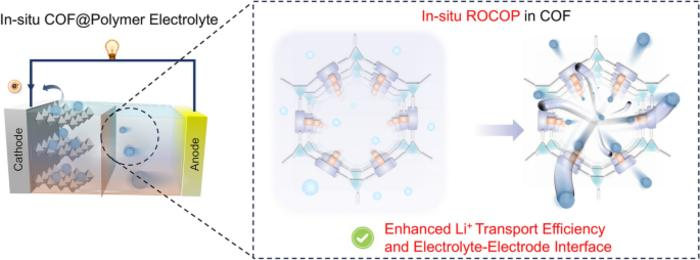Reviewed by Lexie CornerJul 8 2025
Researchers continue to explore ways to improve the performance of solid polymer electrolytes (SPEs) for lithium metal batteries (LMBs), aiming to develop more efficient and sustainable energy storage systems.
Professor Xingping Zhou and Professor Zhigang Xue of Huazhong University of Science and Technology recently published a study describing a new method to enhance lithium-ion conduction in SPEs.
Their approach uses in situ polymerization within a covalent organic framework (COF).
 Solid polymer electrolytes formed in situ via covalent organic framework-induced ring-opening copolymerization. Solid polymer electrolytes with a high lithium-ion transference number and desirable interfacial compatibility. Li⁺ migration mechanisms investigated with density functional theory and molecular dynamics simulations. Image Credit: Junchen Meng, Mengjia Yin, Kairui Guo, Xingping Zhou, Zhigang Xue.
Solid polymer electrolytes formed in situ via covalent organic framework-induced ring-opening copolymerization. Solid polymer electrolytes with a high lithium-ion transference number and desirable interfacial compatibility. Li⁺ migration mechanisms investigated with density functional theory and molecular dynamics simulations. Image Credit: Junchen Meng, Mengjia Yin, Kairui Guo, Xingping Zhou, Zhigang Xue.
Why This Research Matters
-
Improved Ion Transport Efficiency: Traditional SPEs often have limited ion transport, which restricts their use in high-performance lithium metal batteries. This method, which combines the structure of covalent organic frameworks (COFs) with in situ polymerization, enhances ion transport pathways. As a result, it increases both ionic conductivity and lithium-ion transference numbers.
-
Better Electrode–Electrolyte Interface: In situ polymerization improves the distribution of COFs within the polymer matrix. This reduces interfacial resistance and stabilizes the interface between the electrode and electrolyte. The outcome is better cycling performance and longer battery life.
-
Suitability for High-Voltage Applications: These SPEs show high electrochemical stability and strong ionic conductivity, making them suitable for high-voltage cathodes. This expands their potential for use in next-generation lithium metal batteries.
Innovative Design and Mechanisms
-
Covalent Organic Framework (COF): COFs are well-suited for constructing high-performance SPEs due to their ordered ion transport channels, chemical stability, high surface area, and customizable functional sites. In this study, the anionic COF TpPa-COOLi was used. It can accelerate ring-opening copolymerization (ROCOP) of cyclic lactone monomers, enabling the in situ formation of SPEs.
-
In Situ Polymerization: This method uses the COF’s high surface area to absorb polymerization precursors and speed up polymerization inside the pores. As a result, more COF-polymer interfaces are formed. This improves ion transport pathways and enhances the dispersion of COF within the polymer matrix.
-
Density Functional Theory (DFT) and Molecular Dynamics Simulations: These computational tools were used to study lithium-ion migration and how the polymer interacts with the COF. The results showed that in situ polymerization strengthens the coordination between lithium ions and the polymer, which supports more efficient ion transport.
Applications and Future Outlook
- Lithium Metal Batteries: The in situ polymerized SPEs demonstrated strong electrochemical performance. At room temperature, they achieved an ionic conductivity of 1.1 × 10−5 S cm−1 and a lithium-ion transference number of 0.85. In Li//LFP half-cells, the initial specific capacity was 157.9 mAh g−1 at 0.5C, with a 76 % capacity retention rate after 1000 cycles
- High-Voltage Applications: The SPEs also showed potential for high-voltage systems. They maintained oxidation stability up to 5.0 V with NCM622 cathodes. The Li/polymer@TpPa-COOLi/NCM622 half-cell delivered an initial discharge capacity of 132 mAh g−1 and retained 72 % capacity after 100 cycles.
- Future Research: Upcoming work will focus on simplifying COF synthesis and addressing cost and scalability challenges. The in situ polymerization method may also be adapted for other types of batteries and energy storage technologies.
This approach to enhancing lithium-ion conduction through in situ polymerization within a covalent organic framework represents a meaningful step forward in the development of high-performance lithium metal batteries.
As Professor Xingping Zhou and Professor Zhigang Xue's team at Huazhong University of Science and Technology continues their work, further advancements in energy storage research are expected.
Journal Reference:
Meng, J., et al. (2025). In Situ Polymerization in COF Boosts Li-Ion Conduction in Solid Polymer Electrolytes for Li Metal Batteries. Nano-Micro Letters. doi.org/10.1007/s40820-025-01768-3.